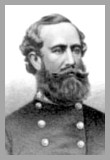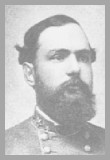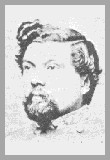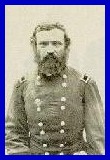| Because
they were operating within Rebel areas, and because they
did not have a complete investment of the Petersburg
lines, the Union rear areas were vulnerable to attack.
This forced Grant to use a lot of troops and effort to
protect his rear, and, on at least one occasion, not
enough protection was had. Confederate cavalry scouts were camped along the Blackwater River downstream of the Federal supply base at City Point, and on September 3rd they told Wade Hampton, Lee's cavalry chief after the death of J.E.B. Stuart, that there was a herd of nearly 3,000 Yankee beef cattle at Coggins Point, about five miles down the James River from City Point. The herd was poorly guarded by about 250 men of the 1st D.C. Cavalry, together with a detachment of about 150 men from the 13th Pennsylvania. This entire Federal rear was picketed by the single understrength cavalry division of Brig. Gen. August Kautz. On September 14th, Hampton led a force of 4,500 men, mostly from Rooney Lee's division but augmented by the brigades of Rosser and Dearing, to capture this herd. The day was chosen in part because Grant was known to be in the Shenandoah Valley in conference with Sheridan. Hampton was able to penetrate the Federal rear by a roundabout route, passing through Dinwiddie Court House and Stony Creek Station, crossing the Blackwater River at the site of a destroyed bridge which was rebuilt on the night of the 15th. At dawn on the16th, Lee's division was used to screen off the Rebel left, as that was the flank closest to the Union lines around Petersburg, while Rosser and Dearing were to attack the camp, capture the herd, and start the cattle on their way back to Southern lines (using a large number of shepherd dogs brought along to help with the herding). The attack was completely successful, although the Federal force held on as long as their small numbers would allow before retreating. An attempt to scatter the herd was thwarted by the fact that the Rebels attacked from all sides, thus hemming in the cattle. Capturing the beef was only the first step; now they had to get back to the Confederate lines with them. By 8:00 a.m., less than three hours after the camp was attacked, Hampton had his force back on the road. Rosser was sent ahead to secure the Jerusalem Plank Road and prevent any Federal force from descending along that avenue. Dearing was sent after Rosser to support him. Lee's division brought up the rear. By 10:00 a.m. they were back at Cook's Bridge on the Blackwater. Federal reaction was limited, mostly because the bulk of the cavalry was with Sheridan in the Shenandoah Valley. The Second Cavalry division, under Brig. Gen. Henry Davies, and the Army of the James cavalry, under Kautz, were hastily sent out after the Rebels, but they were only able to muster some 2,800 men. At about 2:00 p.m. Davies came up against Rosser's force along the Jerusalem Plank Road. He was able to drive Rosser back about three miles before he came upon a prepared position at Belches Mill, held in force (Rosser had now been reinforced by Dearing). Without Kautz's support, Davies did not feel strong enough to engage the Confederates and so simply skirmished with them until about 8:00 p.m. Meanwhile Hampton was getting the cattle across the Jerusalem Plank Road and the Nottoway River, moving about two miles or so south of Rosser's position. Davies eventually decided to move by his right flank to try and bypass Rosser's position and intercept the retreating column, but Hampton anticipated this and during the night moved to Wilkinson's Bridge on Rowanty Creek, where he could block any Federal advance. After driving in some of Hampton's pickets early on the morning of the 17th, Davies learned that the cattle had been taken across the Nottoway the previous day and were therefore "beyond my reach with the force at my disposal" (as he put it in his report). Davies therefore broke off the pursuit. Kautz had followed the line of Hampton's retirement but had never felt strong enough to vigorously engage the Confederate rear-guard, and so had accomplished little except to scoop up some 18 head of cattle that had straggled from the captured herd. In Kautz's defense, he only had about 700 men and Hampton's rear guard was all of Rooney Lee's division. It was one of the most brilliant cavalry raids of the war. At a cost of about 60 men, Hampton had secured nearly 2,500 cattle for Lee's hungry troops. Soon thereafter a reporter asked Grant when he would take Petersburg. "Never," said the Union commander, "if our armies continue to supply him with beef cattle." |
|
|||||
 |
Return to Siege main page. Return to list of accounts. Go to previous page. Go to next page. |






